Biermann Ch. Handbook of Pulping and Papermaking
Подождите немного. Документ загружается.

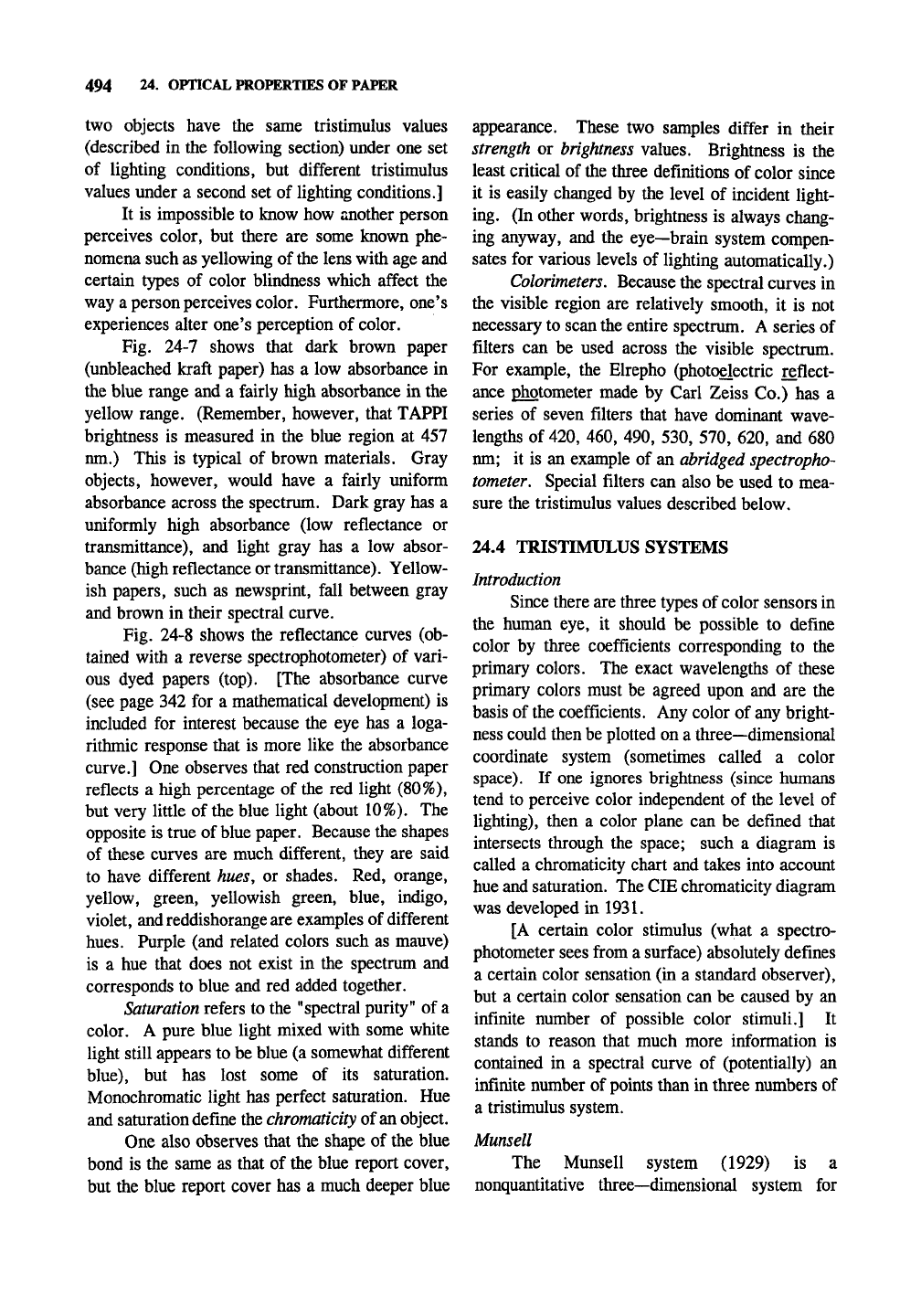
494 24. OPTICAL PROPERTIES OF PAPER
two objects have the same tristimulus values
(described in the following section) under one set
of lighting conditions, but different tristimulus
values under a second set of lighting conditions.]
It is impossible to know how another person
perceives color, but there are some known phe-
nomena such as yellowing of
the
lens with age and
certain types of color blindness which affect the
way a person perceives color. Furthermore, one's
experiences alter one's perception of color.
Fig. 24-7 shows that dark brown paper
(unbleached kraft paper) has a low absorbance in
the blue range and a fairly high absorbance in the
yellow range. (Remember, however, that TAPPI
brightness is measured in the blue region at 457
nm.) This is typical of brown materials. Gray
objects, however, would have a fairly uniform
absorbance across the spectrum. Dark gray has a
uniformly high absorbance (low reflectance or
transmittance), and light gray has a low absor-
bance (high reflectance or transmittance). Yellow-
ish papers, such as newsprint, fall between gray
and brown in their spectral curve.
Fig. 24-8 shows the reflectance curves (ob-
tained with a reverse spectrophotometer) of vari-
ous dyed papers (top). [The absorbance curve
(see page 342 for a mathematical development) is
included for interest because the eye has a loga-
rithmic response that is more like the absorbance
curve.] One observes that red construction paper
reflects a high percentage of the red light (80%),
but very little of the blue light (about 10%). The
opposite is true of blue paper. Because the shapes
of these curves are much different, they are said
to have different hues, or shades. Red, orange,
yellow, green, yellowish green, blue, indigo,
violet, andreddishorangeare examples of different
hues.
Purple (and related colors such as mauve)
is a hue that does not exist in the spectrum and
corresponds to blue and red added together.
Saturation refers to the "spectral purity" of a
color. A pure blue light mixed with some white
light still appears to be blue (a somewhat different
blue),
but has lost some of its saturation.
Monochromatic light has perfect saturation. Hue
and saturation define the
chromaticity
of an object.
One also observes that the shape of the blue
bond is the same as that of the blue report cover,
but the blue report cover has a much deeper blue
appearance. These two samples differ in their
strength or brightness values. Brightness is the
least critical of the three definitions of color since
it is easily changed by the level of incident light-
ing. (In other words, brightness is always chang-
ing anyway, and the eye—brain system compen-
sates for various levels of lighting automatically.)
Colorimeters, Because the spectral curves in
the visible region are relatively smooth, it is not
necessary to scan the entire spectrum. A series of
filters can be used across the visible spectrum.
For example, the Elrepho (photoelectric reflect-
ance photometer made by Carl Zeiss Co.) has a
series of seven filters that have dominant wave-
lengths of 420, 460, 490, 530, 570, 620, and 680
nm; it is an example of an abridged spectropho-
tometer. Special filters can also be used to mea-
sure the tristimulus values described below.
24.4 TRISTIMULUS SYSTEMS
Introduction
Since there are three types of color sensors in
the human eye, it should be possible to define
color by three coefficients corresponding to the
primary colors. The exact wavelengths of these
primary colors must be agreed upon and are the
basis of the coefficients. Any color of any bright-
ness could then be plotted on a three—dimensional
coordinate system (sometimes called a color
space).
If one ignores brightness (since humans
tend to perceive color independent of the level of
lighting), then a color plane can be defined that
intersects through the space; such a diagram is
called a chromaticity chart and takes into account
hue and saturation. The CIE chromaticity diagram
was developed in 1931.
[A certain color stimulus (what a spectro-
photometer sees from a surface) absolutely defines
a certain color sensation (in a standard observer),
but a certain color sensation can be caused by an
infinite number of possible color stimuli.] It
stands to reason that much more information is
contained in a spectral curve of (potentially) an
infinite number of points than in three numbers of
a tristimulus system.
Munsell
The Munsell system (1929) is a
nonquantitative three—dimensional system for
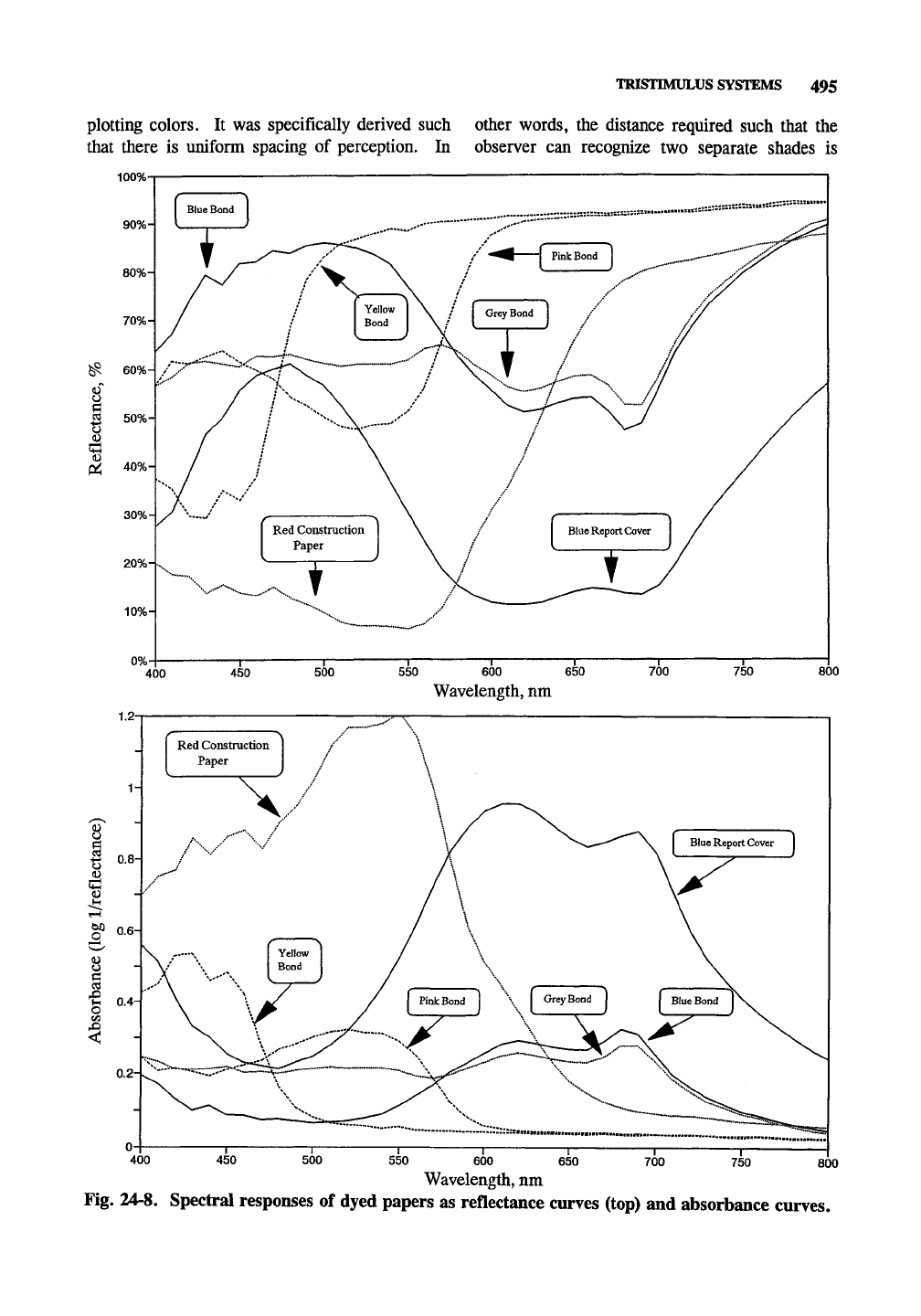
TRISTIMULUS SYSTEMS 495
plotting colors. It was specifically derived such other words, the distance required such that the
that there is uniform spacing of perception. In observer can recognize two separate shades is
100%-
80%H
0%-
,,««"-«::"""-""-""’"’’’""""’"’
400
^
450
500
,
550
600
650
700 750 800
Wavelength, nm
1.2-
O
Red Construction
Paper
Fig.
400
24-8.
-T
750
450 500 550 600 650 700 750 800
Wavelength, nm
Spectral responses of dyed papers as reflectance curves (top) and absorbance curves

496 24. OPTICAL PROPERTIES OF PAPER
about the same throughout the system. The
Munsell value corresponds to brightness from
black (0) to perfect diffuse reflectance (10). The
Munsell hue and chroma are the other axes.
CIE system
The first quantitative tristimulus system was
developed by the CIE (Commission Internationale
de I'Eclairage), which defines the internationally
accepted standard observer (since perception of
color is observer—dependent), used in the other
systems. (Older literature calls this the ICI sys-
tem.) The 1931 observer is based on the average
2° vision of 17 observers, while this was expand-
ed to 76 observers in 1964. The sample is illumi-
nated at a 45° angle with observations at 0°. (A
45° illumination with 45° observation is an obser-
vation of incident light, which has a higher pro-
portion of the color source characteristics.)
Since the color of an object is dependent
upon the source of the illumination, several stan-
dard illuminants were also specified (Section 24-
5).
Illuminant A corresponds to a tungsten light
operating at a temperature of 2854 K. Illuminant
B corresponds to direct sunlight, and Illuminant C,
perhaps the most common reference illuminant,
corresponds to north sky (in the northern
hemisphere) average diffuse daylight (as on an
overcast day); obviously these illuminants are
simulated in the laboratory with a specified ar-
rangement. Illuminant Dgs is also daylight but
specifies the UV and visible region for use in
fluorescence; it is also widely used as the refer-
ence for color television
monitors.
Illuminant E is
a theoretical source of pure white light.
CIE tristimulus values are obtained for a
given set of lighting conditions (for expected
further illumination of the object, such as paper
expected to be viewed under diffuse sunlight)
since, as has been said, two objects that appear the
same color under one set of lighting conditions
may appear different under a second set of lighting
conditions. The light source used when the CIE
values are determined must also be specified since
the light shining on the object partly determines
the spectral reflectance of the object. Usually the
light source is Illuminant E, perfectly white light,
(unless fluorescence is being considered in which
case Illuminant D is specified), since a spectro-
photometer operates as if the light source is pure
white light, because the light reflected off a sam-
ple is always compared to the light incident on the
sample for each wavelength under consideration.
For example, an object with Illuminant E
may have several different sets of tristimulus
values corresponding to a set for use in tungsten
light illumination, direct sunlight illumination, or
diffuse sunlight illumination. If one has a
reflectance curve then the tristimulus values can be
obtained with a computer that automatically factors
in the effect of any light source used to generate
the reflectance curve.
The 1931 CIE RGB system was defined with
primaries of red, R, at 700.0 nm; green, G, at
546.1 nm; and blue, B, at 435.8 nm. While the
exact selection of wavelengths is arbitrary, they
were selected from regions of the primary colors,
according to Grassman's (published in 1853) laws
of color mixing (Brunner et al., 1990). When the
relative amounts of each of these colors were
added together to match monochromatic light of
each wavelength across the spectrum (based on the
agreement of a group of standard observers), the
result in Fig. 24-9 was obtained, which is a plot of
the tristimulus values. However, this necessarily
led to negative values of the red primary in order
to match some colors (the mathematical equivalent
of having to add red primary to the sample to
obtain perceived agreement).
In order to avoid the use of negative values,
primaries (color matching functions) that had no
physical meaning were selected in the CIE XYZ
system so that positive values of each could be
combined to make any color of the spectrum (the
first criterion). (It was more important that certain
criteria be met rather than have color matching
functions that could be physically reproduced.)
The coefficients of the three color matching
functions at any particular wavelength are desig-
nated jc, y, and ?, respectively. The green
primary function, y , was chosen to match the
standard luminosity function (sometimes called
visual efficiency in older literature) of
the
standard
observer (the second criterion). The blue primary
function, ?, was chosen to be zero over as much
of the visible spectrum as possible (the third
criterion). The tristimulus values of each of the
three XI^ primaries are given in Fig. 24-10 at 10
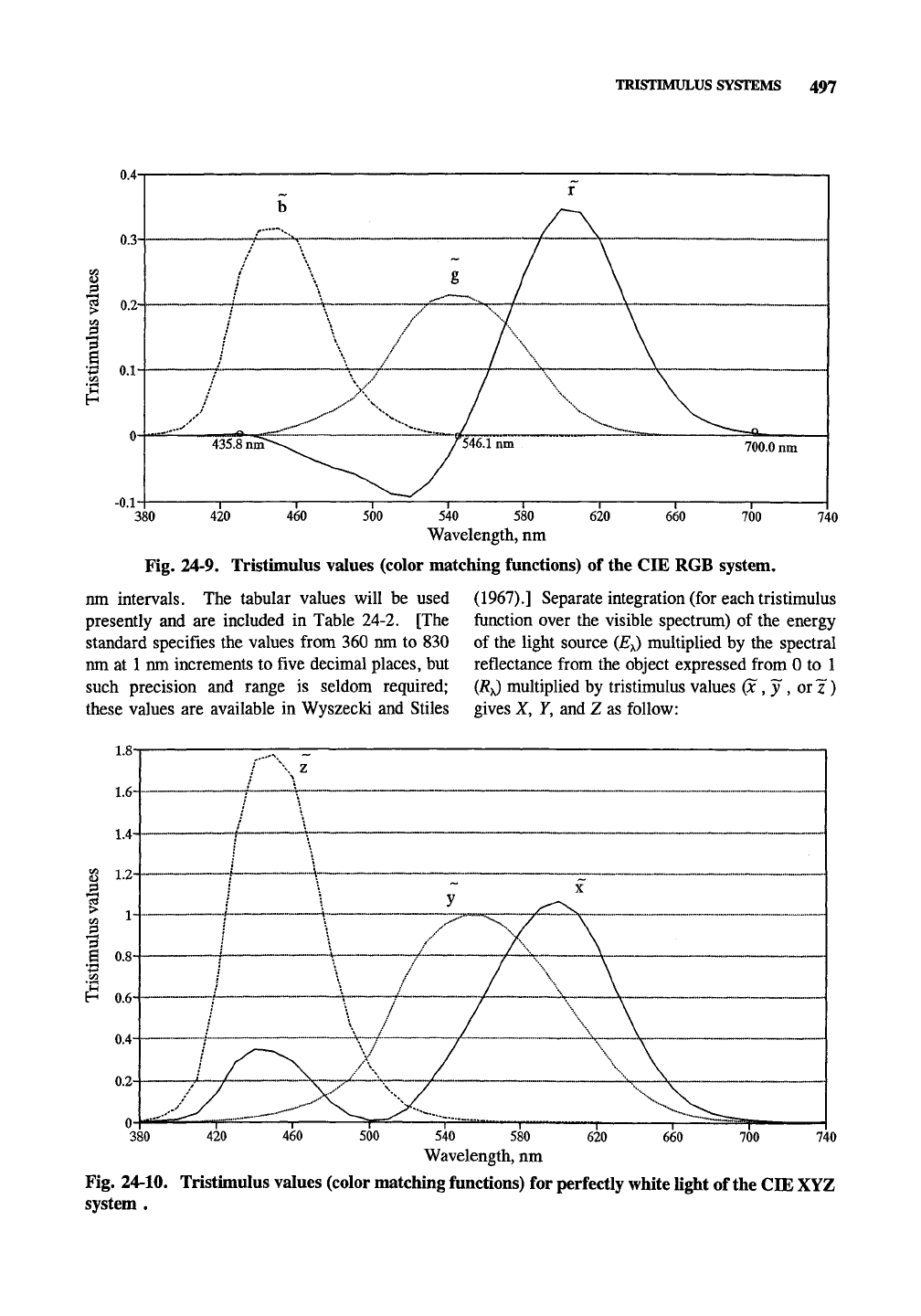
TRISTIMULUS SYSTEMS 497
380 420
620
660
700
580
Wavelength, nm
Fig. 24-9. Tristimulus values (color matching functions) of the CIE RGB system.
740
nm intervals. The tabular values will be used
presently and are included in Table 24-2. [The
standard specifies the values from 360 nm to 830
nm at 1 nm increments to five decimal places, but
such precision and range is seldom required;
these values are available in Wyszecki and Stiles
(1967).] Separate integration (for each tristimulus
function over the visible spectrum) of the energy
of the light source
(E^)
multiplied by the spectral
reflectance from the object expressed from 0 to 1
{R^
multiplied by tristimulus values (x ,y , oil)
gives X, y, and Z as follow:
420
540
580
Wavelength, nm
Fig. 24-10. Tristimulus values (color matching functions) for perfectly white light of the CIE XYZ
system .

498
24.
OPTICAL PROPERTIES OF PAPER
Z
=
C{E.ZR. dk
where
C=100/({E^y d\)
(By these definitions, Y will always be 100
for perfectly white light.) The integration is
approximated by a summation, such as by taking
values at every 10 nm from 380 nm to 720 nm (dX
« AX = 10 nm); high precision, of course,
requires a smaller increment. High precision is
obtained by taking smaller increments where the
functions have high values in the selected
ordinate
integration
method.
Tables that give intensities for
each wavelength (or every 10 nm) for a particular
standard illuminant simplify the calculations.
Many computerized spectrophotometers have the
software to makes these calculations automatically.
The fourth criterion of the three color func-
tions is that white light corresponds to X = 7 =
Z.
The three chromaticity coordinates are the
ratio of each of the tristimulus values divided by
the sum of all three tristimulus values. This gives
the ratios of the three tristimulus values with loss
of the overall magnitude information. The three
equations are:
X = XI{X + y + Z)
y = YI{X ^ Y -¥Z)
z = ZI{X -^Y+Z)
Any two of these specify the third since x +
y + z = 1. The use of x and y alone in a plot
(since the value of z is implicit mx + y) allows
all colors to be plotted in a two—dimensional
system where the overall brightness is ignored.
(The selection of x and y is arbitrary; a plot of
any two of the variables would have worked.)
Therefore, the chromaticity
diagram
is a plot
of
X
and y values as shown in Fig. 24-11 [with the
data obtained from Wyszecki and Stiles (1967)].
The data are plotted every 10 nm from 380 nm to
720 nm; plotting every 1 nm would have made
the curve smoother. Let us examine how the
points on a chromaticity chart are determined and
what they represent.
The simplest example
is
monochromatic light.
For example, let us determine the point for blue
light at 450 nm. Since overall brightness is not
considered, consider all light to be in units from 0
to 1 transmittance. Monochromatic light at 450
nm corresponds to 0 at all wavelengths and 1 at
450 nm. From Table 24-2, X, 7, and Z are
calculated as 0.3362, 0.0380, and 1.7721, respec-
tively. The solutions of x and y are then
0.3362/2.1463 and 0.0380/2.1463 or 0.1566 and
0.0177, respectively. Fig. 24-11 shows the
location of this point at those coordinates. Thus,
points on the outer "circle" represents monochro-
matic light.
White light is another useful example, but
takes a little more work. One takes the light
output for each wavelength and multiplies by the
factors in Table 24-2. It is important that the
spacing of the wavelengths be equal so that one
wavelength does not have more weight than
another in the calculations (unless one wants to
divide each increment by the wavelength interval).
But using a relative light output at each wave-
length of 1, a simple sum is taken as shown in
Table 24-2. Since all of the sums are equal, it
follows that
jc
= y = z = 0.3333.
The lower line connects monochromatic blue
and red lights in various proportions to obtain
various shades of
purple.
Obviously this does not
occur when light is separated with a prism, but
can nevertheless occur to make colors.
If monochromatic green light of wavelength
520 nm is mixed with various parts of white light
the line is obtained that goes from 520 nm to
white (achromatic) light. This line corresponds to
various shades (various excitation purities) of the
same hue (dominant wavelength). A color, there-
fore,
can be described by its dominant wavelength
and excitation purity or its x and y values.
The reduced CIE Y, x, y system uses x and
y and retains 7 for a measurement of brightness.
A problem of the system demonstrated in
Fig. 24-11 is that the sensitivity to changes in
color by the human eye varies greatly in different
regions of the plot. A perception of color change
in the green area corresponds to a much larger
distance than in the red area. This should not be
surprising since the CIE XYZ space is not a
uniform color space as is the Munsell system.
[See McAdam, J. Opt. Soc. Am. 32:247(1942).]
Also,
there is no area that corresponds to black.
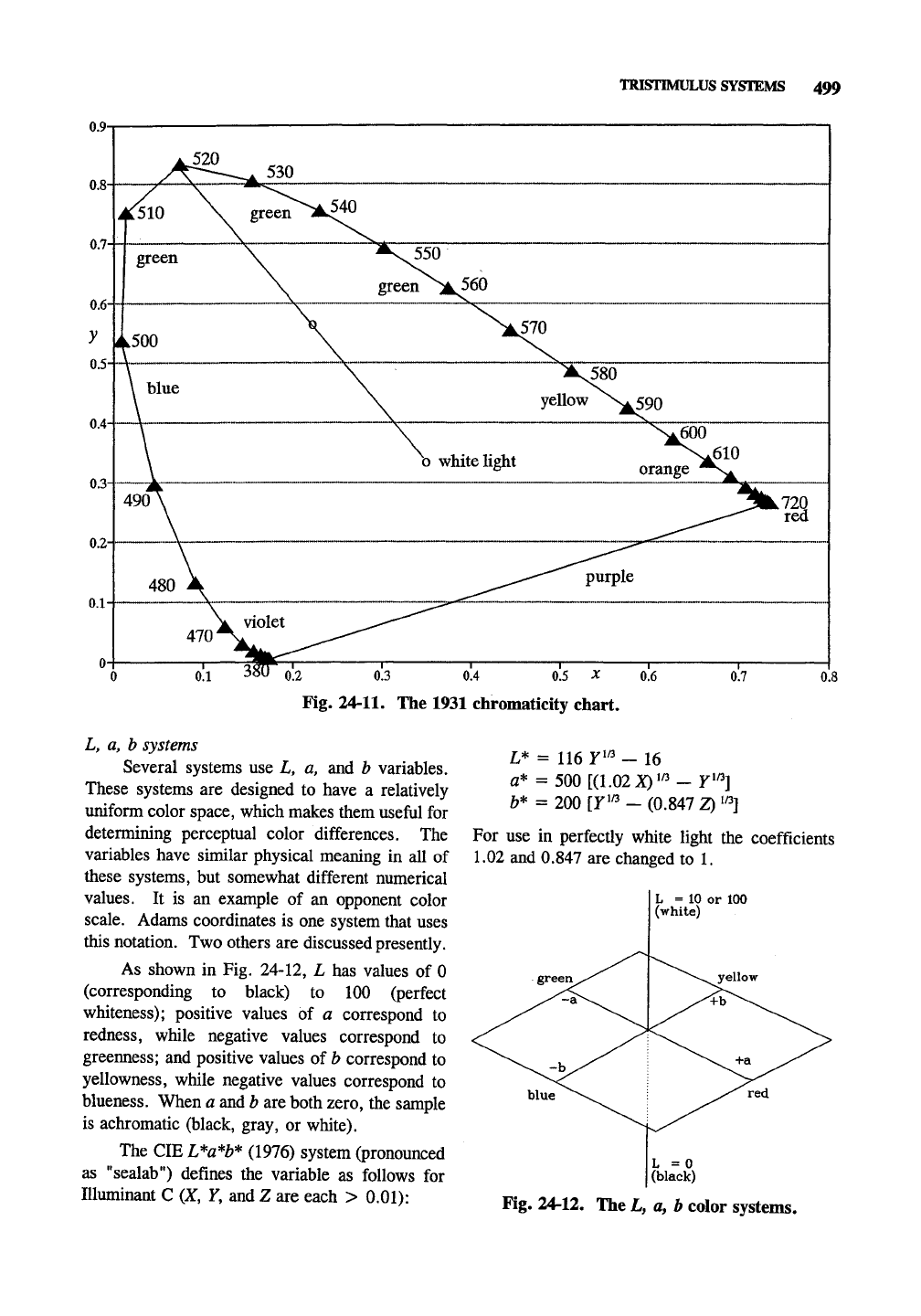
TRISTIMULUS SYSTEMS 499
0.3 0.4 0.5 X 0.6
Fig.
24-11.
The 1931 chromaticity chart.
L,
a, b systems
Several systems use L, a, and b variables.
These systems are designed to have a relatively
uniform color space, which makes them useful for
determining perceptual color differences. The
variables have similar physical meaning in all of
these systems, but somewhat different numerical
values. It is an example of an opponent color
scale. Adams coordinates is one system that uses
this notation. Two others are discussed presently.
As shown in Fig. 24-12, L has values of 0
(corresponding to black) to 100 (perfect
whiteness); positive values of a correspond to
redness, while negative values correspond to
greenness; and positive values of b correspond to
yellowness, while negative values correspond to
blueness. When a and b are both zero, the sample
is achromatic (black, gray, or white).
The CIE L*fl*Z?* (1976) system (pronounced
as "sealab") defines the variable as follows for
Illuminant C (Z, 7, and Z are each > 0.01):
L* = 116 Y"^ - 16
a* = 500 [(1.02X)^^^-Y'^]
b* = 200[Y^^-(OM1Z)^^]
For use in perfectly white light the coefficients
1.02 and 0.847 are changed to 1.
L = 10 or 100
(white)
L =0
(black)
Fig. 24-12. The L, a, b color systems.
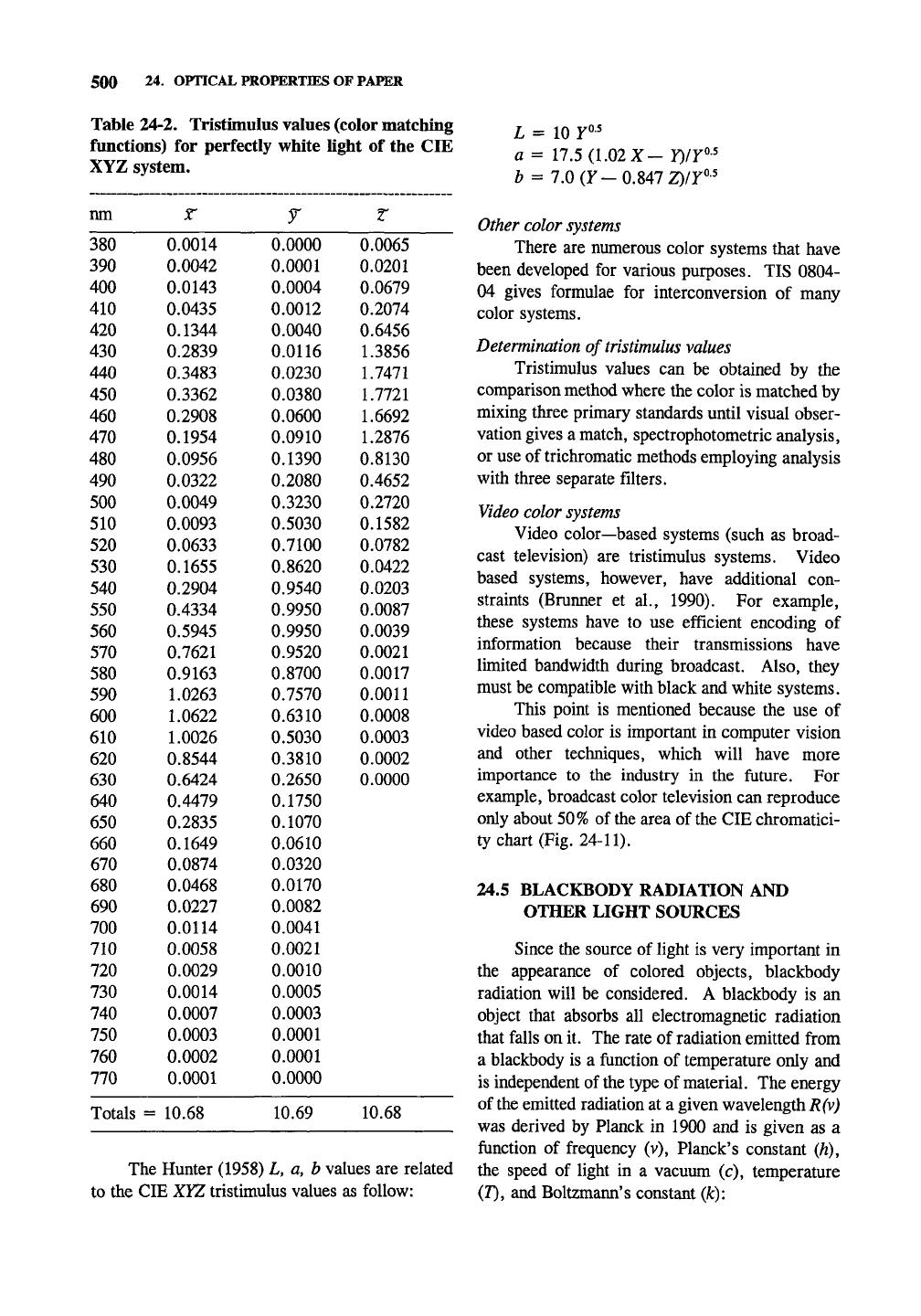
500 24. OPTICAL PROPERTIES OF PAPER
Table 24-2. Tristimulus values (color matching
functions) for perfectly white light of the CIE
XYZ system.
nm
380
390
400
410
420
430
440
450
460
470
480
490
500
510
520
530
540
550
560
570
580
590
600
610
620
630
640
650
660
670
680
690
700
710
720
730
740
750
760
770
Totals
r
0.0014
0.0042
0.0143
0.0435
0.1344
0.2839
0.3483
0.3362
0.2908
0.1954
0.0956
0.0322
0.0049
0.0093
0.0633
0.1655
0.2904
0.4334
0.5945
0.7621
0.9163
1.0263
1.0622
1.0026
0.8544
0.6424
0.4479
0.2835
0.1649
0.0874
0.0468
0.0227
0.0114
0.0058
0.0029
0.0014
0.0007
0.0003
0.0002
0.0001
=
10.68
r
0.0000
0.0001
0.0004
0.0012
0.0040
0.0116
0.0230
0.0380
0.0600
0.0910
0.1390
0.2080
0.3230
0.5030
0.7100
0.8620
0.9540
0.9950
0.9950
0.9520
0.8700
0.7570
0.6310
0.5030
0.3810
0.2650
0.1750
0.1070
0.0610
0.0320
0.0170
0.0082
0.0041
0.0021
0.0010
0.0005
0.0003
0.0001
0.0001
0.0000
10.69
r
0.0065
0.0201
0.0679
0.2074
0.6456
1.3856
1.7471
1.7721
1.6692
1.2876
0.8130
0.4652
0.2720
0.1582
0.0782
0.0422
0.0203
0.0087
0.0039
0.0021
0.0017
0.0011
0.0008
0.0003
0.0002
0.0000
10.68
The Hunter (1958) L, a, b values are related
to the CIE XYZ tristimulus values as follow:
L = 10 Y^'
a = 17.5 (1.02 X- y)/7«-^
h = 7.0(y-0.847 2:)/7«-^
Other color systems
There are numerous color systems that have
been developed for various purposes. TIS 0804-
04 gives formulae for interconversion of many
color systems.
Determination of
tristimulus
values
Tristimulus values can be obtained by the
comparison method where the color is matched by
mixing three primary standards until visual obser-
vation gives a match, spectrophotometric analysis,
or use of trichromatic methods employing analysis
with three separate filters.
Video color systems
Video color—based systems (such as broad-
cast television) are tristimulus systems. Video
based systems, however, have additional con-
straints (Brunner et al., 1990). For example,
these systems have to use efficient encoding of
information because their transmissions have
limited bandwidth during broadcast. Also, they
must be compatible with black and white systems.
This point is mentioned because the use of
video based color is important in computer vision
and other techniques, which will have more
importance to the industry in the future. For
example, broadcast color television can reproduce
only about 50% of the area of the CIE chromatici-
ty chart (Fig. 24-11).
24.5 BLACKBODY RADIATION AND
OTHER LIGHT SOURCES
Since the source of light is very important in
the appearance of colored objects, blackbody
radiation will be considered. A blackbody is an
object that absorbs all electromagnetic radiation
that falls on it. The rate of radiation emitted from
a blackbody is a function of temperature only and
is independent of
the
type of
material.
The energy
of
the
emitted radiation at a given wavelength R(v)
was derived by Planck in 1900 and is given as a
function of frequency (v), Planck's constant (/z),
the speed of light in a vacuum (c), temperature
(7),
and Boltzmann's constant
Qc):
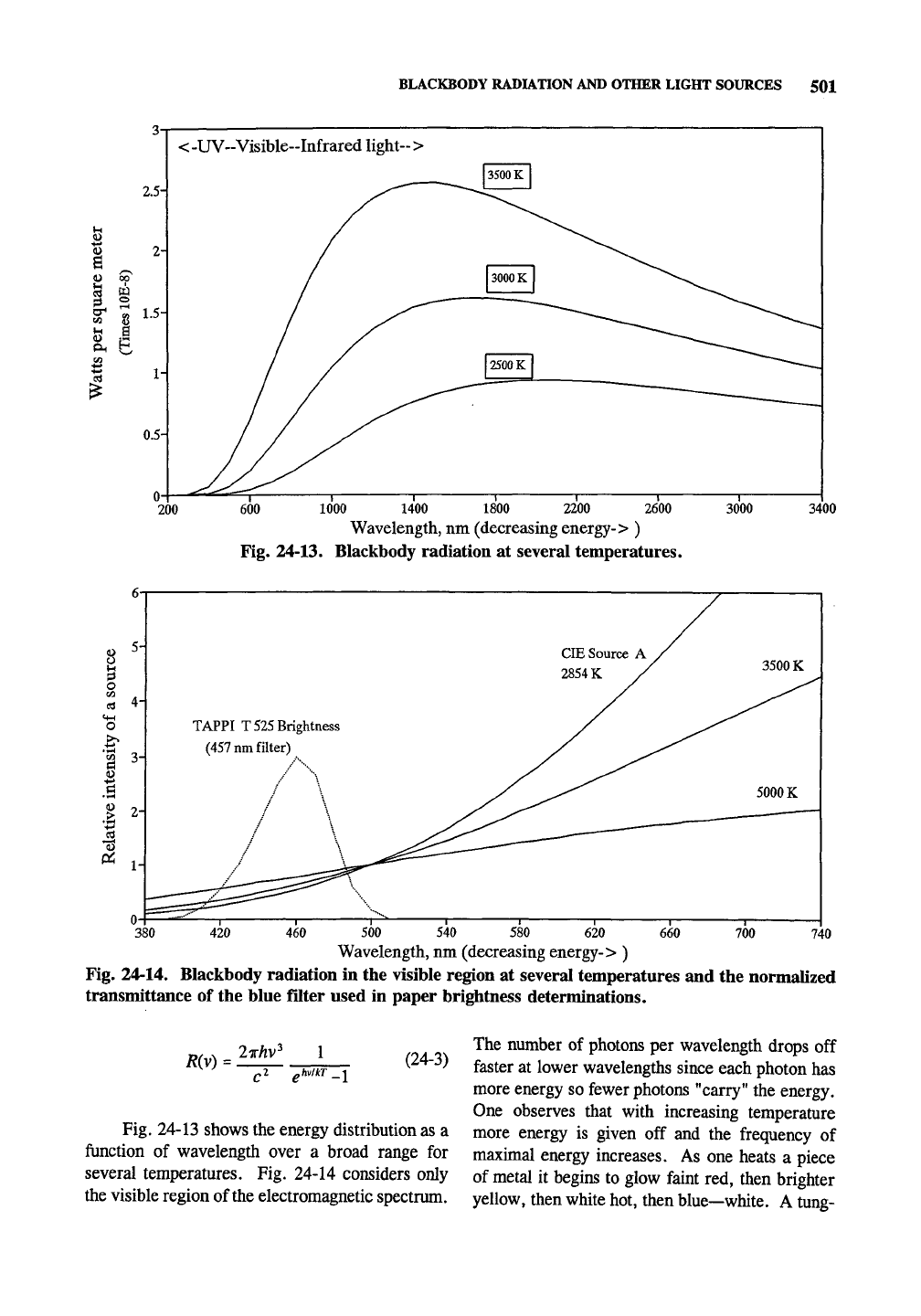
BLACKBODY RADIATION AND OTHER LIGHT SOURCES 501
2.5
<D
••-»
^
e
(U
1
CO
s
o^
^
^
00
o
.1
a
V,-
1.5-
1
0.5H
200
600
1000 1400 1800 2200 2600
Wavelength, nm (decreasing energy-> )
Fig. 24-13. Blackbody radiation at several temperatures.
3400
(4-4
o
I
41
3H
TAPPI T
525
Brightness
(457 nm filter)
380
460
TOO"
740
500 540 580 620
Wavelength, nm (decreasing energy-> )
Fig. 24-14. Blackbody radiation in the visible region at several temperatures and the normalized
transmittance of the blue filter used in paper brightness determinations.
R(v)
lirhv^
(24-3)
Fig. 24-13 shows the energy distribution as a
function of wavelength over a broad range for
several temperatures. Fig. 24-14 considers only
the visible region of the electromagnetic spectrum.
The number of photons per wavelength drops off
faster at lower wavelengths since each photon has
more energy so fewer photons "carry" the energy.
One observes that with increasing temperature
more energy is given off and the frequency of
maximal energy increases. As one heats a piece
of metal it begins to glow faint red, then brighter
yellow, then white hot, then blue—white. A tung-
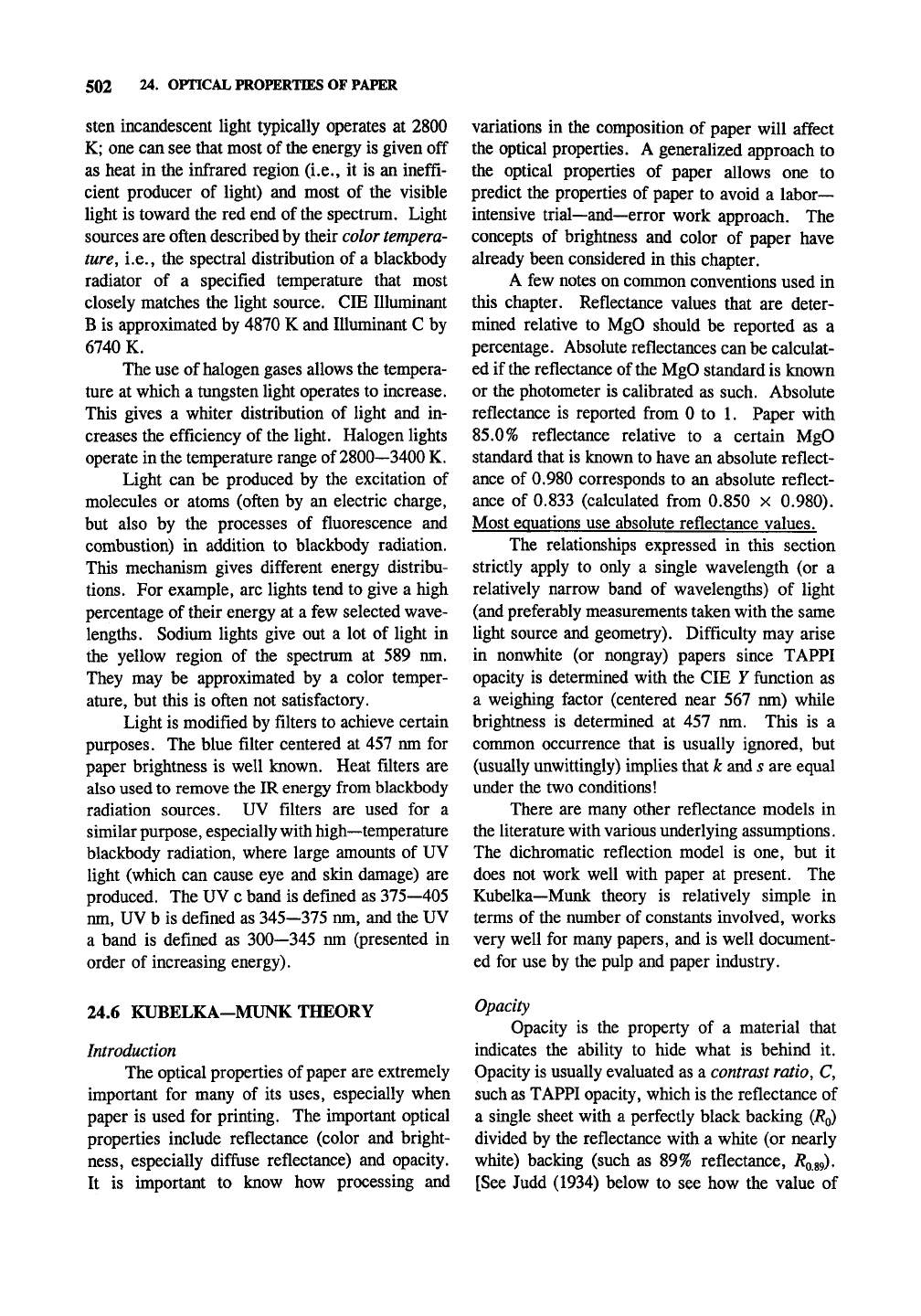
502 24. OPTICAL PROPERTIES OF PAPER
sten incandescent light typically operates at 2800
K; one can see that most of the energy is given off
as heat in the infrared region (i.e., it is an ineffi-
cient producer of light) and most of the visible
light is toward the red end of the spectrum. Light
sources are often described by their color
tempera-
ture, i.e., the spectral distribution of a blackbody
radiator of a specified temperature that most
closely matches the light source. CIE lUuminant
B is approximated by 4870 K and lUuminant C by
6740 K.
The use of halogen gases allows the tempera-
ture at which a tungsten light operates to increase.
This gives a whiter distribution of light and in-
creases the efficiency of the light. Halogen lights
operate in the temperature range of 2800—3400 K.
Light can be produced by the excitation of
molecules or atoms (often by an electric charge,
but also by the processes of fluorescence and
combustion) in addition to blackbody radiation.
This mechanism gives different energy distribu-
tions.
For example, arc lights tend to give a high
percentage of their energy at a few selected wave-
lengths. Sodium lights give out a lot of light in
the yellow region of the spectrum at 589 nm.
They may be approximated by a color temper-
ature, but this is often not satisfactory.
Light is modified by filters to achieve certain
purposes. The blue filter centered at 457 nm for
paper brightness is well known. Heat filters are
also used to remove the IR energy from blackbody
radiation sources. UV filters are used for a
similar
purpose,
especially with high—temperature
blackbody radiation, where large amounts of UV
light (which can cause eye and skin damage) are
produced. The UV c band is defined as 375—405
nm, UV b is defined as 345—375 nm, and the UV
a band is defined as 300—345 nm (presented in
order of increasing energy).
variations in the composition of paper will affect
the optical properties. A generalized approach to
the optical properties of paper allows one to
predict the properties of paper to avoid a labor-
intensive trial—and—error work approach. The
concepts of brightness and color of paper have
already been considered in this chapter.
A few notes on common conventions used in
this chapter. Reflectance values that are deter-
mined relative to MgO should be reported as a
percentage. Absolute reflectances can be calculat-
ed if
the
reflectance of the MgO standard is known
or the photometer is calibrated as such. Absolute
reflectance is reported from 0 to 1. Paper with
85.0%
reflectance relative to a certain MgO
standard that is known to have an absolute reflect-
ance of 0.980 corresponds to an absolute reflect-
ance of 0.833 (calculated from 0.850 x 0.980).
Most equations use absolute reflectance values.
The relationships expressed in this section
strictly apply to only a single wavelength (or a
relatively narrow band of wavelengths) of light
(and preferably measurements taken with the same
light source and geometry). Difficulty may arise
in nonwhite (or nongray) papers since TAPPI
opacity is determined with the CIE Y function as
a weighing factor (centered near 567 nm) while
brightness is determined at 457 nm. This is a
common occurrence that is usually ignored, but
(usually unwittingly) implies that k and s are equal
under the two conditions!
There are many other reflectance models in
the literature with various underlying assumptions.
The dichromatic reflection model is one, but it
does not work well with paper at present. The
Kubelka—Munk theory is relatively simple in
terms of the number of constants involved, works
very well for many papers, and is well document-
ed for use by the pulp and paper industry.
24.6 KUBELKA-MUNK THEORY
Introduction
The optical properties of paper are extremely
important for many of its uses, especially when
paper is used for printing. The important optical
properties include reflectance (color and bright-
ness,
especially diffuse reflectance) and opacity.
It is important to know how processing and
Opacity
Opacity is the property of a material that
indicates the ability to hide what is behind it.
Opacity is usually evaluated as a contrast ratio, C,
such as TAPPI opacity, which is the reflectance of
a single sheet with a perfectly black backing (i?o)
divided by the reflectance with a white (or nearly
white) backing (such as 89% reflectance, /^Q.SQ)-
[See Judd (1934) below to see how the value of
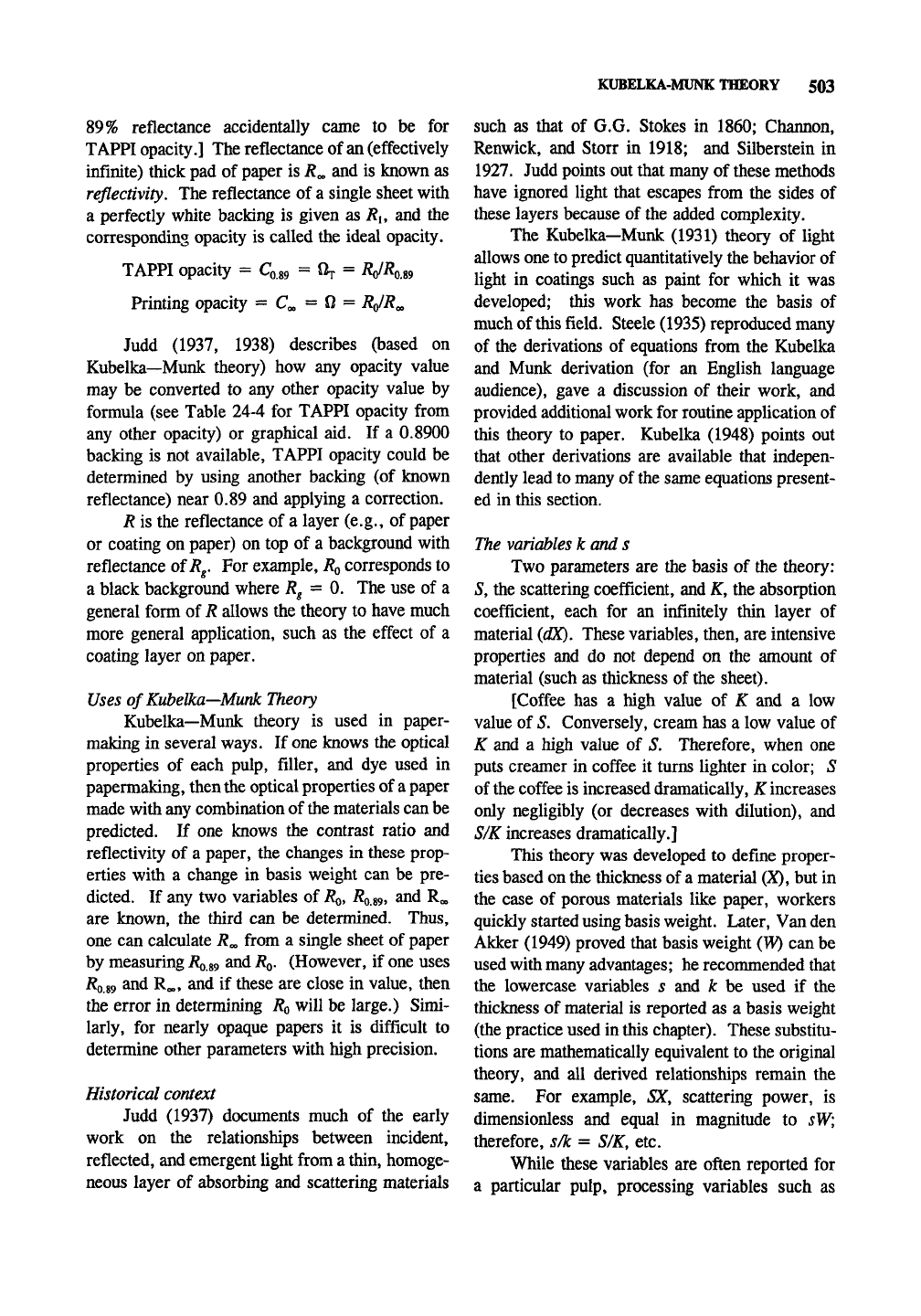
KUBELKA-MUNK THEORY 503
89%
reflectance accidentally came to be for
TAPPI opacity.] The reflectance of
an
(effectively
infinite) thick pad of paper is R„ and is known as
reflectivity. The reflectance of
a
single sheet with
a perfectly white backing is given as R^ and the
corresponding opacity is called the ideal opacity.
TAPPI opacity = Qsp = Or =
Ro/Ro,s9
Printing opacity = C«, = 0 =
RQ/RO.
Judd (1937, 1938) describes (based on
Kubelka—Munk theory) how any opacity value
may be converted to any other opacity value by
formula (see Table 24-4 for TAPPI opacity from
any other opacity) or graphical aid. If a 0.8900
backing is not available, TAPPI opacity could be
determined by using another backing (of known
reflectance) near 0.89 and applying a correction.
R is the reflectance of a layer (e.g., of paper
or coating on paper) on top of a background with
reflectance ofRg. For example,
RQ
corresponds to
a black background where
Rg
= 0. The use of a
general form of R allows the theory to have much
more general application, such as the effect of a
coating layer on paper.
Uses of
Kubelka—Munk Theory
Kubelka—Munk theory is used in paper-
making in several ways. If one knows the optical
properties of each pulp, filler, and dye used in
papermaking, then the optical properties of
a paper
made with any combination of
the
materials can be
predicted. If one knows the contrast ratio and
reflectivity of a paper, the changes in these prop-
erties with a change in basis weight can be pre-
dicted. If any two variables of
RQ,
Ro^g,
and
R^,
are known, the third can be determined. Thus,
one can calculate R^ from a single sheet of paper
by measuring
RQ^^
and
RQ.
(However, if one uses
jRo.89
2^^
Roo, and if these are close in value, then
the error in determining
RQ
will be large.) Simi-
larly, for nearly opaque papers it is difficult to
determine other parameters with high precision.
Historical
context
Judd (1937) documents much of the early
work on the relationships between incident,
reflected, and emergent light from
a
thin,
homoge-
neous layer of absorbing and scattering materials
such as that of G.G. Stokes in 1860; Channon,
Renwick, and Storr in 1918; and Silberstein in
1927. Judd points out that many of these methods
have ignored light that escapes from the sides of
these layers because of the added complexity.
The Kubelka—Munk (1931) theory of light
allows one to predict quantitatively the behavior of
light in coatings such as paint for which it was
developed; this work has become the basis of
much
of this field. Steele (1935) reproduced many
of the derivations of equations from the Kubelka
and Munk derivation (for an English language
audience), gave a discussion of their work, and
provided additional work for routine application of
this theory to paper. Kubelka (1948) points out
that other derivations are available that indepen-
dently lead to many of
the
same equations present-
ed in this section.
The variables
k and s
Two parameters are the basis of the theory:
S, the scattering coefficient, and K, the absorption
coefficient, each for an infinitely thin layer of
material
(dX),
These variables, then, are intensive
properties and do not depend on the amount of
material (such as thickness of the sheet).
[Coffee has a high value of K and a low
value of 5. Conversely, cream has a low value of
K and a high value of S. Therefore, when one
puts creamer in coffee it turns lighter in color; S
of
the
coffee is increased dramatically, ^increases
only negligibly (or decreases with dilution), and
S/K
increases dramatically.]
This theory was developed to define proper-
ties based on the thickness of
a
material (X), but in
the case of porous materials like paper, workers
quickly
started using
basis weight. Later, Van den
Akker (1949) proved that basis weight (W) can be
used with
many
advantages; he recommended that
the lowercase variables s and k be used if the
thickness of material is reported as a basis weight
(the practice used
in this
chapter). These substitu-
tions are mathematically equivalent to the original
theory, and all derived relationships remain the
same. For example, SX, scattering power, is
dimensionless and equal in magnitude to sW;
therefore, s/k = S/K, etc.
While these variables are often reported for
a particular pulp, processing variables such as
